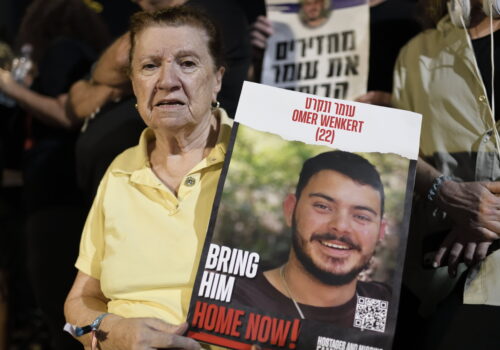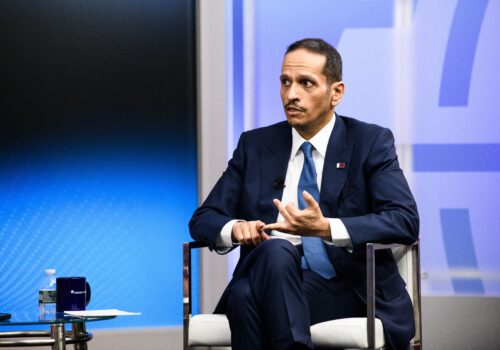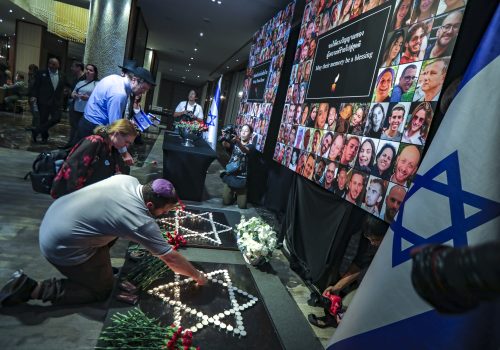Arab-Israelis are facing a crisis. But there’s a way out.
In the wake of the October 7, 2023, Hamas terror attack and subsequent war, Israel’s internal security apparatus, the Israel Security Agency, reported escalated concerns of violence between the country’s Jewish and Arab populations. This is not a fabricated anxiety. Many Israelis fear a repeat of the violence experienced in Israel’s mixed cities during the 2021 Israel-Palestine conflict. Thankfully, through the work of Jewish and Arab leaders, that has not happened to date. Even so, the threat of internal violence remains. The latest hostilities may sensitize Israel’s government and the Jewish majority to the real costs of a continuing crisis among its Arab citizens—one that encompasses but is not limited to higher intra-communal violence and lower educational and economic achievement—to all Israelis.
Arab-Israelis, Arab citizens of Israel living within the country’s official borders, have struggled relative to Jewish communities for decades. The causes are many. Discrimination against minorities is hardly unique to Israel and occurs against the incommensurable security challenges faced by the Jewish state. But much of the crisis is caused by demography and the ineffective retail political strategies pursued by Israel’s Arab minority. There is low-hanging fruit here that provides an opportunity to ameliorate the crisis and spark further progress.
Sign up for the the latest updates from the Middle East and North Africa
Year after year, crime rates—specifically violent crime rates—rise at an unprecedented rate. In 2023, 244 Arab-Israelis were killed in crime-related events. From 2018-2022, 70 percent of those killed in crime-related incidents were Arab despite making up only 21 percent of Israel’s population. By and large, these are intra-community crimes.
According to a study by the Taub Center for Social Policy Studies in Israel, the rising Arab-sector murder rate correlates to a few demographic factors. There is a population bulge of young Arabs from their late teens to mid-twenties. Arabs aged eighteen to twenty-two comprise the highest percentage of Arabs in any age demographic category: 29 percent compared to the overall 21 percent. The study observed “a positive and statistically significant correlation” between “the rate of growth in the number of Arab men aged 18-22 and both the murder rate and self-reported feelings of a lack of security.” Simultaneously, as the number of young Arab-Israeli men grows, so too has their unemployment rate. Even before the COVID-19 pandemic, the unemployment rate rose 7 percent in two years, reportedly due to disparate skills and demands of the labor market.
The study points to the lack of higher education among Israeli-Arab men as another factor driving the crime rate. Only 18 percent of men in their thirties hold bachelor’s degrees compared to 47 percent of non-Haredi Jewish men and 35 percent of Arab-Israeli women of the same age group. Not only does this impact their employability in Israel’s modern economy, but it has shifted gender attitudes and marriage norms. In the past decade, the number of Arab-Israeli women earning college degrees has doubled, affording them higher employment rates and greater independence. As a result, divorce rates in Arab communities have grown, and Arab-Israeli women are increasingly marrying non-Arab-Israeli men. Arab-Israeli men seeking marriage will face even greater challenges moving forward. Currently, the average age difference for intra-marriages within the Arab-Israeli community is six years. This will become increasingly problematic as, in coming years, there will be 5-10 percent more eligible men for marriage than women. These compounding factors of demographics, education, and marriage are pushing young Arab-Israeli men to the margins of their communities despite comprising a significant portion of the population.
High poverty rates and underfunding of education further exacerbate the issues facing Israeli-Arab communities. In 2015, they received approximately $4,110 per primary student compared to about $5,150 per primary student in the Hebrew system (no other study exists to date). The reasons behind this discrepancy are complicated. The Israeli education system offers students the choice between primarily Hebrew and primarily Arabic instruction, with further options between secular schools and a variety of religious ones. In practicality, geography is a significant determinant of school choice. In Arab-Israeli towns, it is unlikely to find a predominantly Hebrew school.
Israeli schools also have multiple sources of funding. The central government provides most schools’ budgets. Ninety-five percent of its resources are distributed equally between students, with the remaining 5 percent allocated based on socioeconomic conditions. In 2018, 45.3 percent of Arab-Israeli families fell below the poverty line compared to just 13.4 percent of Jewish families. The disparity in funding, therefore, does not come from the central government but from the ability of localities to provide their schools with additional funding. Considering that in 2023, 53 percent of Arab-Israeli households were living in poverty, Arab-Israeli communities are limited in the support they can provide. The effects of this discrepancy are detrimental to the success and well-being of Arab-Israelis. There is a direct correlation between school budgets and scores on Israeli university matriculation exams. The lack of a college degree, especially for men, impacts their job prospects, leaving them far more likely to remain in the cycle of unemployment, poverty, and crime, keeping schools underfunded for the next generation.
The Israeli government is aware of the challenges present in Arab-Israeli communities. At the end of 2015, the Knesset adopted a five-year plan to improve Arab sector economic development, integrate it into broader Israeli society, and narrow the socio-economic gap between Arab and Jewish communities. The plan allocated $2.6 billion to education, transportation, healthcare, and employment—an amount meant to be proportional to the Arab share of the population. A second five-year plan with a budget of almost $10.8 billion was passed in 2021 by the Naftali Bennet and Yair Lapid government. Significantly, this was the first governing coalition in Israel’s history to include an Arab party.
When the current government came to power in December 2022, Bezalel Smotrich, the controversial far-right Religious Zionist leader, was appointed as finance minister. In subsequent months, he froze the release of $54 million designated by the five-year plan for Arab municipal authorities, citing an insufficient “supervisory mechanism” to prevent the funds from falling into the hands of criminals. This action was followed by calls from other ministers to review or even reallocate the funds. After a stalemate followed by the outbreak of the Israel-Hamas war, Interior Minister Moshe Arbel overrode Smotrich’s decision on November 1, 2023, sending the frozen funds, as well as an additional $62 million of emergency funds, to the Arab municipalities.
Why Israel should care
While the current war between Israel and Hamas presents many domestic challenges, it also displays to Jewish Israelis why they must care about the country’s Arab citizens. Eighty percent of Arab-Israelis oppose the October 7, 2023 attacks carried out by Hamas, and 66 percent support Israel’s right to defend itself against the terrorist group, according to a poll by the Agam Institute and Hebrew University. Similarly, another poll by the Center for Democratic Values and Institutions (Arab Society in Israel Program) noted that 56 percent believe the attacks “do not reflect Arab society, the Palestinian people, and the Islamic nation.”
Though this support is likely to wane as Israel carries out its counter-offensive in Gaza, the initial numbers show that Arab-Israelis have a sense of camaraderie with their fellow citizens. These are perhaps the most “pro-Israel” numbers to be found in the Arab world. Arab-Israelis were among those killed and kidnapped on October 7, 2023, and they were also among those saving Israeli lives. And there are numerous Arab-Israeli soldiers in the Israel Defense Forces (IDF) fighting against the country’s enemies.
Israel also has much to gain from properly addressing the issues facing the Arab sector. Israel’s always-prevalent security concerns regarding domestic and West Bank terrorism have heightened during the war. The more that Arab citizens identify with their fellow Israelis, the less support extreme factions of Arab-Israeli society will receive, and the more secure all Israelis will be and feel. Economically, the cost of investing in the growth and development of Arab-Israelis now will be far less than the cumulative cost of indefinitely providing large amounts of welfare and managing the effects of poverty. The economic success of Arab-Israelis will help integrate them into Israeli society, aid in improving the crime rate, and bolster Israel’s economy. Arab-Israelis should feel as though their fate is tied to the fate of their fellow citizens and vice versa. When Israel prospers, all its citizens prosper; when Israel suffers, all its citizens suffer.
Opportunities for social and policy changes
In order to solve the Arab sector crisis, both Jewish and Arab leadership need to commit to change. Jewish political leaders must recognize the role of Arab society in Israel and the importance of helping it prosper. The five-year plans were a step in the right direction. The crisis cannot be rectified without purposeful and sufficient funding, and the whims of politicians should never condition this funding. However, funding alone is inadequate. The money must reach the sectors where it is most needed and effective. This will require the input and expertise of local Arab-Israeli leaders familiar with the crisis and affected communities.
Additional avenues for integration and development should also be explored. Israel and the international community have long invested in people-to-people interactions between Jews and Arabs, but these experiences should be the norm and not the exception. Schools are a prime environment to house these programs. Geographic constraints and religious education complicate the integration of such programs into the regular school day, but after-school and extra-curricular activities could be effective. Not only would these programs create more face-to-face time between Jewish and Arab youth, but they also would emphasize the relevance and importance of school.
Tackling the crisis cannot solely focus on the next generation, though. Continuing adult education and skill acquisition programs can both help change the economic realities of Arab-Israeli families in the present moment and enable parents to emphasize the importance of education through their actions. But however ideal, it is unrealistic to expect Jewish politicians to pursue these policies on their own. Securing the necessary funding and support requires partnership and concessions from Arab leaders as well.
The political behavior of Arab-Israeli citizens and politicians must change if they want to see greater government engagement with the crisis. Over the past few decades, Arab voter turnout has waned from 75 percent to 44 percent. To gain political influence, Arab citizens must increase their political involvement and vote in greater numbers. In turn, it is the responsibility of Arab parties to harness the potential of this support. As the 2021 elections proved, Arab parties are most effective when they put aside their political differences and run together in elections. This way, no representation is lost to the 3.25 percent threshold to make it into the Knesset, and Arab parties maintain greater bargaining power.
Another way Arab parties can grow influence in the Knesset is by mimicking the behavior of ultra-orthodox Jewish parties. For much of Israel’s history, ultra-orthodox parties would largely ignore rights versus left politics and join governments based on securing funds and specific, advantageous policies for their communities. Although de-prioritizing other political beliefs in favor of ensuring funding for education and development may not address all communal goals, it can unlock the resources required to address some of them.
However, government action can only go so far. Hopefully, the impact of these policies will promote social values of education and national unity—without which the crisis will continue. On October 7, 2023, Hamas viewed their victims’ religion and ethnicity as secondary to their nationality. Israeli Jews and Israeli Arabs would be wise to do the same.
Rachel Friedman is an Iran research intern at the American Enterprise Institute‘s Critical Threats Project and a former Young Global Professional at the Atlantic Council’s Middle East Programs.
Further reading
Fri, Jan 26, 2024
My son is being held hostage in Gaza. On International Holocaust Remembrance Day, should October 7 be evoked?
MENASource By
The destruction and suffering wrought by Hamas on that horrible day stand alone.
Mon, Jan 29, 2024
Qatar’s prime minister on Israel-Hamas hostage negotiations and the prospects for a two-state solution
Transcript By
At an Atlantic Council Front Page event, Al Thani discussed his country's role in mediating Israel-Hamas hostage negotiations.
Wed, Oct 25, 2023
The kidnapping of a peace activist by Hamas reveals the cruel irony of the situation Israel faces
MENASource By Carmiel Arbit
The hostage crisis Israel is facing is unprecedented. Yet, there is some familiarity with the territory.
Image: An Israeli Arab looks through his shop's window as Israeli soldiers remove a checkpoint in Beit Hanina, on the edge of Jerusalem February 19, 2009. REUTERS/Baz Ratner (JERUSALEM)


